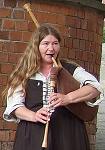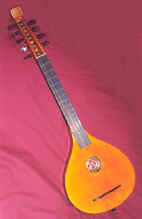
Instruments
Waits played loud wind instruments when they were out of doors: |
|
|
Shawms were the ancestor of the oboe. They were the favourite instrument for Waits to play, and were also known as Wait-pipes. They have a large double reed and a pirouette. They look a bit like recorders and have almost the same fingerings but they are much, much louder! Like recorders they come in different sizes. We have a soprano and an alto: |

|
|
Slide trumpet The slide trumpet was an early attempt to get all the notes of the scale from a trumpet. It could be played like a normal trumpet, for fanfares, but it could also be made to slide up and down on a long tube, so that the length of the instrument changes, giving you different notes. It can't play very fast, and the player has to be careful not to hit himself in the mouth when he moves the slide. It was used to accompany shawms. |
|
|
Sackbuts are very much like trombones today. The main difference is that the bell on the end is smaller. This makes it quieter than a modern trombone, and makes the tone buzz. It has a double slide, which makes it much easier to play than the slide trumpet, because the slide moves instead of the instrument moving, and because you don't have to move the slide so far to get the notes you want. |
|
|
The Cornett and Lysard are like nothing you will ever see in a modern band or orchestra. Made of wood and covered in leather, they have a mouthpiece like a trumpet but finger holes like a recorder. They can be very hard to play but sound beautiful when played well. The cornett gradually took over from the shawm as the main loud, high-pitched wind instrument. A lot of Waits used lysards because they are easier to carry and play whilst walking than a sackbut and were cheaper to make. There is also a bass instrument of the same family called a serpent. |

|
|
Bagpipes were not just played in Scotland in Tudor times – they were a common instrument across Europe and came in all sorts of shapes and sizes. There are three kinds of pipes – one to blow in through, one or more sticking up at the back which play the drone and one or two coming down the front, called chanters, which have finger holes and are used to play tunes. | 
|
For indoor music there were all kinds of quieter instruments as well:
|
|
|
Recorders were popular with the Tudors and were very much like the instruments you play at school. The main differences are that they were made of wood, had only single finger holes at the bottom and were straighter. |

|
|
Harps tended to be smaller than the modern concert harp and had no pedals. Some had metal strings, but most had strings made from sheeps' gut. |

|
|
The Rebec was an ancestor of the violin but it is played lower down the body. This can be very useful if you want to dance while you play. It can have three, four or five strings, made of sheeps' gut, and they can be tuned differently for different pieces of music. |

|
|
The Viella is a type of fiddle, played with a bow. It has four gut strings which can be tuned different ways, and one wire string tuned to the key of the piece being played, which buzzes without being played. There were viellas found on the wreck of Henry VIII's ship, The Mary Rose. |

|
|
The Cittern is just one of the instruments that Tudors had that worked a bit like a guitar. It is strummed with a feather instead of a pick, and has strings made from brass and steel. It was popular with ordinary people to accompany their songs. |

|